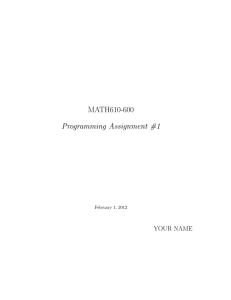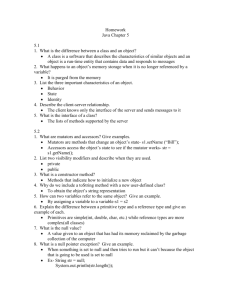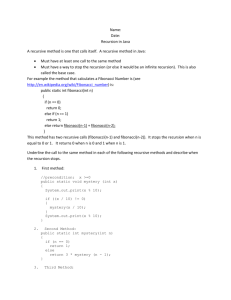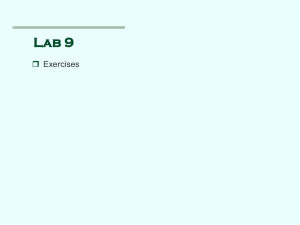CSCI-20 Assignment #1 (100 points) due 2/11/02
advertisement
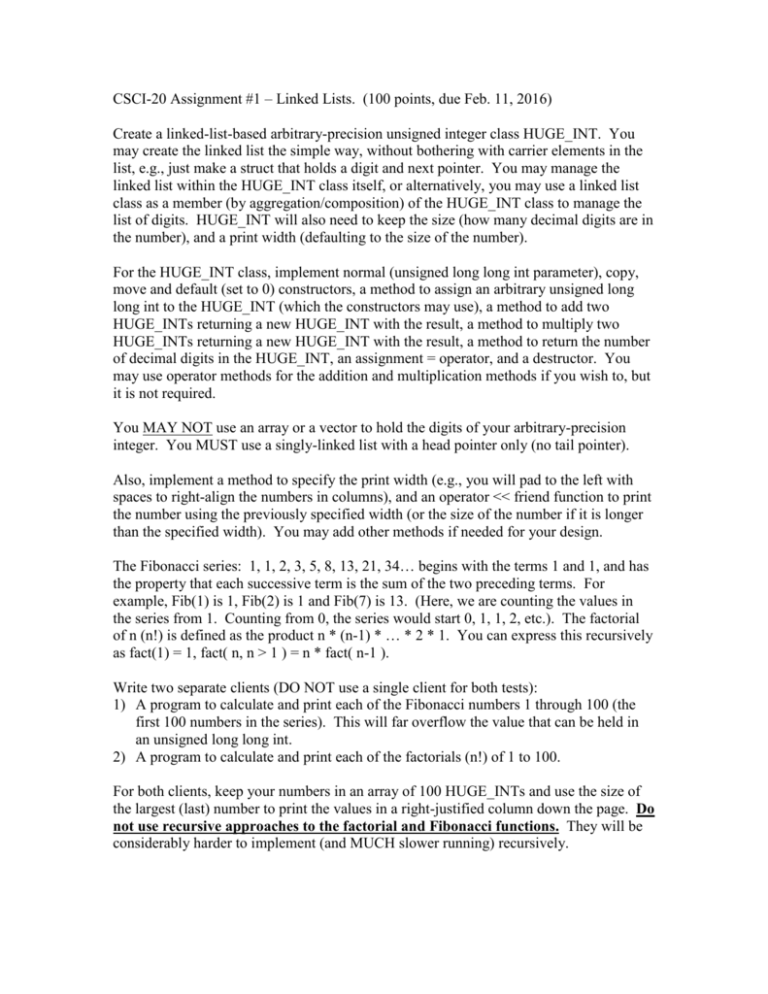
CSCI-20 Assignment #1 – Linked Lists. (100 points, due Feb. 11, 2016) Create a linked-list-based arbitrary-precision unsigned integer class HUGE_INT. You may create the linked list the simple way, without bothering with carrier elements in the list, e.g., just make a struct that holds a digit and next pointer. You may manage the linked list within the HUGE_INT class itself, or alternatively, you may use a linked list class as a member (by aggregation/composition) of the HUGE_INT class to manage the list of digits. HUGE_INT will also need to keep the size (how many decimal digits are in the number), and a print width (defaulting to the size of the number). For the HUGE_INT class, implement normal (unsigned long long int parameter), copy, move and default (set to 0) constructors, a method to assign an arbitrary unsigned long long int to the HUGE_INT (which the constructors may use), a method to add two HUGE_INTs returning a new HUGE_INT with the result, a method to multiply two HUGE_INTs returning a new HUGE_INT with the result, a method to return the number of decimal digits in the HUGE_INT, an assignment = operator, and a destructor. You may use operator methods for the addition and multiplication methods if you wish to, but it is not required. You MAY NOT use an array or a vector to hold the digits of your arbitrary-precision integer. You MUST use a singly-linked list with a head pointer only (no tail pointer). Also, implement a method to specify the print width (e.g., you will pad to the left with spaces to right-align the numbers in columns), and an operator << friend function to print the number using the previously specified width (or the size of the number if it is longer than the specified width). You may add other methods if needed for your design. The Fibonacci series: 1, 1, 2, 3, 5, 8, 13, 21, 34… begins with the terms 1 and 1, and has the property that each successive term is the sum of the two preceding terms. For example, Fib(1) is 1, Fib(2) is 1 and Fib(7) is 13. (Here, we are counting the values in the series from 1. Counting from 0, the series would start 0, 1, 1, 2, etc.). The factorial of n (n!) is defined as the product n * (n-1) * … * 2 * 1. You can express this recursively as fact(1) = 1, fact( n, n > 1 ) = n * fact( n-1 ). Write two separate clients (DO NOT use a single client for both tests): 1) A program to calculate and print each of the Fibonacci numbers 1 through 100 (the first 100 numbers in the series). This will far overflow the value that can be held in an unsigned long long int. 2) A program to calculate and print each of the factorials (n!) of 1 to 100. For both clients, keep your numbers in an array of 100 HUGE_INTs and use the size of the largest (last) number to print the values in a right-justified column down the page. Do not use recursive approaches to the factorial and Fibonacci functions. They will be considerably harder to implement (and MUCH slower running) recursively. I want to see your design in lab in a week, and your code in lab to discuss with you before you turn it in, at least a few days before it's due. Email me your class implementation file, the header file and the two test client programs, as well as the output from your test runs. Hints: This is a LOT easier to do if the digits are kept right-to-left in the list, e.g., the least significant digit is at the head of the list. To print the number, print any spaces you need to align first, and then print the digits in reverse order. Work out the decimal algorithms you learned in elementary school for addition and multiplication by hand: the algorithms map directly to the code. DO NOT try to implement subtraction or division. Please… The 100th Fibonacci number is big: 354224848179261915075 100! is really big: 933262154439441526816992388562667004907159682643816214685929638952175999 932299156089414639761565182862536979208272237582511852109168640000000000 00000000000000 You can check your output values easily on the Web.

